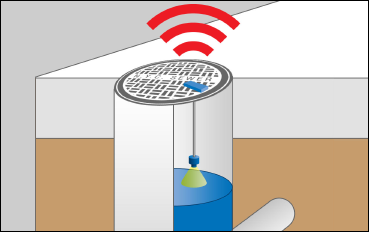 September 24, 2012 CONTACT: Chris Gilbride / Corey Chambliss (718) 595-6600 DEP Installs Manhole Monitoring Sensors to Detect Elevated Flow LevelsMonitoring Sensors Detect Elevated Flow Levels, Send Alerts for Inspection and Preventative Maintenance;
New York City Department of Environmental Protection (DEP) Commissioner Carter Strickland today announced the installation of monitoring sensors on 21 manhole covers throughout the city, technology that will alert DEP to elevated flow levels in sewer pipes and allow staff to perform inspections and preventative maintenance. The equipment is installed on the underside of manhole covers and uses sensors to measure the flow level in the sewer pipe below the roadway. To test the effectiveness of the monitoring technology, DEP is conducting a pilot program with 11 installations in Queens, five in Brooklyn, and five in Staten Island. DEP will expand the pilot with an additional 20 installations by spring 2013. The monitoring technology represents a $300,000 capital investment in optimizing the performance of the city’s sewer infrastructure and is part of DEP’s overall effort to incorporate Geographic Information System (GIS) technology and predictive tools into the sewer maintenance and repair program. “Maintaining our 7,400 miles of sewer lines requires the smart allocation of resources and this monitoring technology will alert us to the areas that are most in need of attention,” said Commissioner Strickland. “When elevated flow levels are detected our staff will be able to inspect, and if necessary perform maintenance, on the sewer line and stop a problem before it gets worse.” When the monitoring sensors detect an elevated flow level in the sewer pipe below the roadway, an alert is sent to DEP borough command centers. Borough managers then dispatch crews to inspect the sewer pipe, and perform any necessary maintenance to prevent potential sewer backups. Preventative maintenance on sewer lines can enhance system capacity and improve the flow of wastewater, helping to prevent the system from being overwhelmed during heavy rain. One major inhibitor to sewer flow is grease from residential and commercial properties. The monitoring sensor pilot follows a recent $24 million infrastructure upgrade in Forest Hills, Queens, which included the installation of approximately one mile of new sewer lines and half a mile of new water mains. In June, DEP completed a two year project during which it cleaned 26 miles of its largest sewer pipes, removing nearly 29 million pounds of debris and sediment and providing roughly 1.9 million gallons of extra sewer capacity during wet weather. DEP’s Executive Budget includes more than $3.4 billion in water and sewer infrastructure investments for Fiscal Years 2012 to 2021—including nearly $2 billion for sewers—of which $238 million will fund high-level storm sewers to mitigate combined sewer overflows and sewer backups. Since 2002, DEP has built a robust GIS tool containing digital, searchable maps of all sewer lines, manholes, and other infrastructure to help identify trends and improve preventative maintenance. In 2011, these programs were combined into a single management program that identifies best practices for proactive intervention by field crews. DEP manages the city’s water supply, providing more than one billion gallons of water each day to more than nine million residents, including eight million in New York City. The water is delivered from a watershed that extends more than 125 miles from the city, comprising 19 reservoirs, and three controlled lakes. Approximately 7,000 miles of water mains, tunnels, and aqueducts bring water to homes and businesses throughout the five boroughs, and 7,400 miles of sewer lines and 96 pump stations take wastewater to 14 in-city treatment plants. DEP employs nearly 6,000 employees, including nearly 1,000 in the upstate watershed. For more information, visit www.nyc.gov/dep, like us on Facebook at www.facebook.com/nycwater, or follow us on Twitter at www.twitter.com/nycwater. | ||